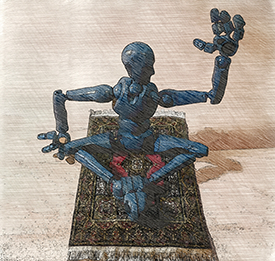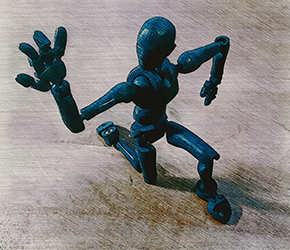
The candle holder, aka Alexander Yanai 18
For all the bother about email, one aspect of this means of communicating that I love is how easy it has become for students to interact with the teacher. Along with exchanging text messages/SMS and interacting via each course’s MIM online forum, following up on a student’s questions no longer has to wait until the next class session anymore. Whether it’s the student who is struggling with a question or someone who needs time to reflect on their experience before they have any questions, these modes of interacting keep the conversation alive and allow for a personal, dyadic dialogue.
After one such recent exchange, one student wrote to say,
Thanks, Larry that really clarified my understanding tremendously. I was a bit flummoxed by the constraints I asked you about. I have a long way to go but I’m progressing slowly but surely. It’s like learning a new language in some ways. Your approach to unlocking and deconstructing the lesson has been wonderfully helpful in deciphering the lessons, so I feel more competent to teach them.
Thinking you might be curious about what she’s referring to, I asked my colleague for her permission to share our dialogue and she graciously gave her blessing. Her part of our exchange is in italics below:

I am about to teach AY 18 CHANUKIA, THE CANDLE HOLDER. I broke the lesson up into 2 classes.
Good idea.
I am trying to understand the constraints and wondered if you could help me on 2 variations.
I’ll do my best.
The red thread seems to be moving the ribcage, scapula, and sternum to allow more freedom in the thoracic spine.

To my mind, that’s more a synopsis of the lesson.
When I think about the Red Thread, I’m thinking of the movement behind an Awareness Through Movement® lesson, the pattern that connects each step to the others. In the case of AY 18, I’d say that the lesson is about connecting the rotation of the arms to flexion, extension, and rotation of the spine.
I understand when the soles of the feet are together, it constrains the rolling from one hip to the other so you feel more in the ribcage.
This position, sitting with knees out to the side and  the soles of the feet together, reverses the normal relationship between your pelvis (the proximal aspect) and legs (which are distal), requiring the pelvis to move around your legs rather than the other way around, that is to say, it means that movement initiates from the pelvis.
the soles of the feet together, reverses the normal relationship between your pelvis (the proximal aspect) and legs (which are distal), requiring the pelvis to move around your legs rather than the other way around, that is to say, it means that movement initiates from the pelvis.
But when we get on our knees, I think we are still containing the pelvis somewhat
Do you mean “constraining?”
and hence feeling more in the ribcage, plus we are adding gravity
Well, gravity is always here, isn’t it?
What happens when students go from sitting to half-kneeling, is that they change their relationship to gravity and their base of support.
and changing the center of the body in this shortened pose. Not sure of the effect of these last 2 variables have on wringing out the arms/hands.
In this section, MF first says, “You can notice that leaning on one side is easier than the other . . . [t]hat you bend your chest on one side and make an effort in your pelvis on the other. This implies that you are not doing the movement symmetrically . . . [t]he whole activation of the back is different.“
Then he asks the students to do the opposite, turning the head toward the hand behind, saying that “[a]s long as you cannot do the opposite, you do not know how to do the regular pattern . . . [Y]ou are like a machine if you don’t know how to make a mistake.”
That being so, I’d say that he is using this position — which is less stable than sitting on the floor and which allows the pelvis greater motion than foot-soles — because it’s easier for students to notice and begin to understand the asymmetry of their own movements.
Then when we stand one foot, we become asymmetrical and make the pelvis even less flexible.
Because it is so vague, “less flexible” is the kind of phrase that hides more than it reveals.
First of all, the pelvis, itself, isn’t flexible. And it shouldn’t be. It is a bone; well, to be more precise, it is an aggregate of fused bones that move as one piece.

In the half-kneeling position, the movement of the student’s pelvis around their legs is necessarily different in each hip joint, which means the spine is asked to move differently on one side compared to the other. Having highlighted the symmetry in the previous steps, MF proceeds to ask students to do the movement asymmetrically, meaning that one half-kneeling position will go with the existing habitual pattern and the other against it. He takes this to the extreme by asking students to look under their armpits and reorganize their necks, chests, and shoulder half-girdles.
Yes, the knight’s stance — kneeling on one knee and standing on the other foot — is asymmetrical, especially in terms of the position of the pelvis, the available motion at each hip joint, what that means for the movement of the spine, and, also, in the ways that it challenges a student’s balance.
So movement is easier as you move away from the standing foot. Why does he do this?
The way that I make sense of these variations is to consider each of them in terms of how what happens in each step of the lesson links to the next, how they build on one another, and where they lead.
Can’t help but wonder if, perhaps, you might be missing the forest for the trees?
What I mean is that focusing exclusively on individual steps is limiting your ability to grasp what holds the lesson together. You aren’t changing perspective from observing details to perceiving the bird’s eye view. That makes it difficult, if not impossible, to follow, let alone understand, the learning logic built into the overarching sequence of steps in this — or any other — ATM®.
- Foot-soles make the movement the pelvis explicit and, for many people, applying this configurational constraint helps make the action much easier. (Try doing the lesson skipping that step . . .)
- Kneeling makes it possible to feel the asymmetry of the wringing action on one side compared to the other.
- Half-kneeling highlights, challenges, and begins to unravel the habit.
- Foot-soles make the movement the pelvis explicit and, for many people, applying this configurational constraint helps make the action much easier. (Try doing the lesson skipping that step . . .)
All this means that when students return to the floor, their perceptions of how they are resting on the ground along with their ease and range of motion will have noticeably changed.
If you’d like to listen to and do AY 18, we’re making available the recent recording of my teaching this lesson for the An AY a Day group.
Please log into your Mind in Motion online (MIMO) account and then click here. This brings you to a page where you’ll be able to listen to the audio recording of this lesson immediately or download the file for later.
Before you do this ATM lesson, please note that it is neither medical care nor treatment. If you have any concerns about whether you should do it or not, consult with your physician.
This is just one of the free lessons that’s available on our website. You’ll find other AY lessons along with classic ATMs and my original compositions after you sign into your account by going to Library and then selecting Free ATMs. If you haven’t joined the website yet, it’s quick and easy to create your free account here.
A cool aspect of the meetings of the An AY a Day group is that we stick around after each lesson to discuss the lesson, the method, and our learning. Since these are professional conversations, you’ll need to log into your professional Become A Better Teacher (BABT) account to see the link to this recording .
[If you’re a Feldenkrais® teacher or trainee and you don’t have a BABT account yet, no worries! You can apply for one when you first sign up for a MIMO account or, if you already have an account and you’re logged into the site, request an upgrade from your My Account page.]
Your thoughts?
Please let us know your perspective! Add your comments, reactions, suggestions, ideas, etc., by first logging in to your Mind in Motion account and then clicking here.
Commenting is only available to the Mind in Motion Online community.
Join in by getting your free account, which gives you access to the e-book edition of Articulating Changes (Larry's now-classic Master's thesis), ATM® lessons, and more — all at no charge whatsoever.
To find out more and sign up, please click here.
Please share this blog post
 This work is licensed under a Creative Commons Attribution-ShareAlike 4.0 International License
This work is licensed under a Creative Commons Attribution-ShareAlike 4.0 International License
This blog may contain one or more affiliate links. When you click on a link and then make a purchase, Mind in Motion receives a payment. Please note that we only link to products we believe in and services that we support. You can learn more about how affiliate links work and why we use them here


Responses